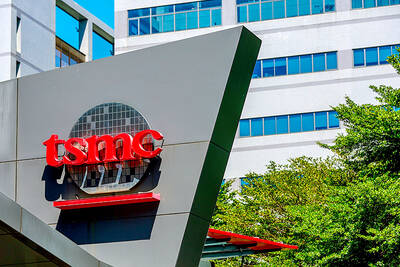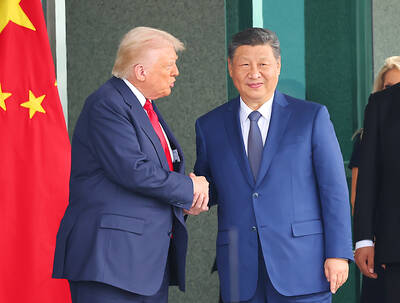The US dollar rose against the New Taiwan dollar on Friday, gaining NT$0.034 to close at NT$32.33, from NT$32.436 on Friday last week, as foreign investors moved funds out of the region, dealers said.
In the wake of the fund outflow, other regional currencies trended lower against the US dollar, which added downward pressure on the Taiwan dollar throughout the session, although buying by Taiwanese exporters in the local unit gave some support to the currency, capping the losses, the dealers said.
The greenback opened at NT$32.27 and moved between NT$32.25 and NT$32.36 before the close. Turnover totaled US$513 million during the trading session.
The US dollar opened lower against the NT dollar as traders here locked in gains they had built up a session earlier, but the greenback soon recouped its losses and traded in positive territory as some foreign investors remitted their funds back to their home markets, the dealers said.
A move by the People’s Bank of China to lower the yuan’s reference rate against the US dollar also led the NT dollar to move lower, they added.
Despite the selling in the NT dollar, turnover in the local foreign exchange market remained moderate as many traders stayed on the sidelines after the European Central Bank (ECB) left its key interest rates unchanged in a policymaking meeting held a day earlier, the dealers said.
The ECB’s decision hurt the appetite of traders in the region to take risks, so that they either shunned non-US dollar-denominated assets or stayed off the trading floor, they said.
Trading in the local foreign exchange market is expected to remain quiet amid cautious sentiment next week before the US Federal Reserve wraps up a two-day policymaking on Wednesday, the dealers said.
With South Korea’s won gaining for a fourth week amid signs of a stabilizing Chinese economy, strategists are questioning how much longer the rally can run.
The won has risen this month as data showed a nascent recovery in Asia’s largest economy and the Fed signaled a slower pace of tightening.
Yet the US dollar has recovered over the last two days as the market’s attention turned to the Fed’s meeting next week, while the Bank of Korea’s reduction of its growth and inflation forecasts raised the chance of an interest-rate cut in the coming months.
“There’s a risk the Fed might sound a bit more hawkish to prepare the market for a rate hike in June,” said Sim Moh Siong, a foreign-exchange strategist at Bank of Singapore Ltd in the city-state. “Under that scenario, the room for the won to further rally may be limited.”
The currency rose 0.3 percent this week to close at 1,143.22 won to the US dollar and declined 0.9 percent on Friday, data compiled by Bloomberg show.
The won has rallied 0.9 percent in the past month, the best performance after Malaysia’s ringgit among emerging-market Asian currencies.

RUN IT BACK: A succesful first project working with hyperscalers to design chips encouraged MediaTek to start a second project, aiming to hit stride in 2028 MediaTek Inc (聯發科), the world’s biggest smartphone chip supplier, yesterday said it is engaging a second hyperscaler to help design artificial intelligence (AI) accelerators used in data centers following a similar project expected to generate revenue streams soon. The first AI accelerator project is to bring in US$1 billion revenue next year and several billion US dollars more in 2027, MediaTek chief executive officer Rick Tsai (蔡力行) told a virtual investor conference yesterday. The second AI accelerator project is expected to contribute to revenue beginning in 2028, Tsai said. MediaTek yesterday raised its revenue forecast for the global AI accelerator used

Taiwan Semiconductor Manufacturing Co (TSMC, 台積電) has secured three construction permits for its plan to build a state-of-the-art A14 wafer fab in Taichung, and is likely to start construction soon, the Central Taiwan Science Park Bureau said yesterday. Speaking with CNA, Wang Chun-chieh (王俊傑), deputy director general of the science park bureau, said the world’s largest contract chipmaker has received three construction permits — one to build a fab to roll out sophisticated chips, another to build a central utility plant to provide water and electricity for the facility and the other to build three office buildings. With the three permits, TSMC

TEMPORARY TRUCE: China has made concessions to ease rare earth trade controls, among others, while Washington holds fire on a 100% tariff on all Chinese goods China is effectively suspending implementation of additional export controls on rare earth metals and terminating investigations targeting US companies in the semiconductor supply chain, the White House announced. The White House on Saturday issued a fact sheet outlining some details of the trade pact agreed to earlier in the week by US President Donald Trump and Chinese President Xi Jinping (習近平) that aimed to ease tensions between the world’s two largest economies. Under the deal, China is to issue general licenses valid for exports of rare earths, gallium, germanium, antimony and graphite “for the benefit of US end users and their suppliers

Dutch chipmaker Nexperia BV’s China unit yesterday said that it had established sufficient inventories of finished goods and works-in-progress, and that its supply chain remained secure and stable after its parent halted wafer supplies. The Dutch company suspended supplies of wafers to its Chinese assembly plant a week ago, calling it “a direct consequence of the local management’s recent failure to comply with the agreed contractual payment terms,” Reuters reported on Friday last week. Its China unit called Nexperia’s suspension “unilateral” and “extremely irresponsible,” adding that the Dutch parent’s claim about contractual payment was “misleading and highly deceptive,” according to a statement